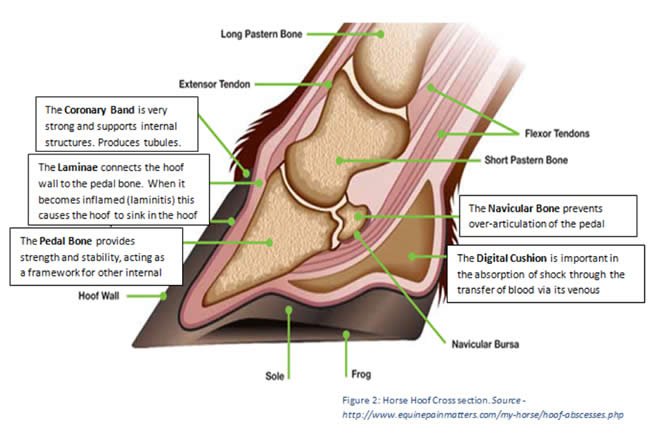Hoof Growth and Maintenance
Many issues faced by horse owners revolve around the quality and integrity of the hoof. The old saying, “no hoof - no horse” is pretty simple but profound in its accuracy. Many of the situations where hooves have begun to breakdown can be related to diet. The link between diet and Laminitis is well known and understood. So it stands to reason that if some nutrients can have a negative influence in hoof health, why can’t others have a positive impact on hoof health. The concept of using nutritional supplements to improve the hoof condition of a horse is not new. Delivering key identified nutrients such as Biotin or Zinc for hoof health can provide some benefit, but may not have as big an impact as desired.

Single nutrient delivery for hoof growth and development makes an assumption that all other nutrients required for the process of growing healthy hooves are present and in the right ratios. You cannot make this assumption.
The process of forming healthy and strong hooves is very complex. The animal needs to take nutrients and pull them apart to their simplest forms and then re-assemble them into a complex protein structure called keratin. This process relies upon several key factors:
- Supply of quality protein
Proteins are bundles of amino acids that are grouped together in a formation with specific ratios and sequences. The way that these amino acids are assembled determines the type and the quality of the protein. Some proteins have more appropriate types of amino acids present for the formation of keratin.
- Minerals
 Minerals can play a key role, not only in the structural formation of hoof tissue but also in the biochemical pathways that stimulate and control the process o f nutrient metabolisation. Zinc and Copper have been identified as key hoof minerals. Technology is allowing us to deliver these nutrients in complex ways through the process of chelation. Chelating is the bonding of these minerals to protein that allows for better nutrient uptake and more accurate amino acid balancing for keratin production.
Minerals can play a key role, not only in the structural formation of hoof tissue but also in the biochemical pathways that stimulate and control the process o f nutrient metabolisation. Zinc and Copper have been identified as key hoof minerals. Technology is allowing us to deliver these nutrients in complex ways through the process of chelation. Chelating is the bonding of these minerals to protein that allows for better nutrient uptake and more accurate amino acid balancing for keratin production.
- Essential Oils
Cellular integrity and elasticity has a very close relationship to the supply of essential oils. They are called essential oils due to the fact they cannot be synthesized within the body, they need to be supplied daily through diet. Commonly known as Omega 6 and Omega 3. These oils need to be supplied in very specific ratios for maximum effect on hoof health.
- Vitamins
Vitamins are essential for correct metabolic function; they play significant roles as co-enzymes for this metabolic function. Co-enzymes work with enzymes to be the controllers of many of the chemical reactions that take place through the breakdown, absorption and utilisation of nutrients. By supplying specific vitamins that influence the formation of healthy keratin, we can significantly assists with the lay down of quality hoof material. Biotin (B7) is one of the key vitamins.
- Probiotics
Horses rely upon a process called fermentation to break down fibrous plant material; this takes place in the cecum (hindgut). Immense colonies of microbes live in the hindgut spending their lifecycle digesting this fibrous material. Through this process of anaerobic (without oxygen) fermentation these “gut bugs” release compounds that become a major energy source for the horse (volatile fatty acids). While these microbes play a very positive role in the digestion of fiber, they also can produce compounds that are very negative to the horse. If some of the these bugs feed too rapidly on starch they can produce a compound known as lactic acid, and lactic acid accumulation is known to be one of the main causes of laminitis. By adding live yeast bacteria (Probiotics) to the diet of the horse, you can change the behavior of the fermentation by influencing the microbial population dynamics. These yeast bacteria can consume the starches faster than other bacteria species without the production of lactic acid. As yeast is an aerobic bacterium, it requires oxygen. The basis of hindgut function relies upon anaerobic fermentation. Having a bacteria population that is actively consuming the available oxygen in the hindgut produces a more stable and beneficial fermentation. Resulting in a healthier horse, with decreased lactic acid accumulation.
Kool Glow exclusively contains Vistacell as a probiotic. Research has shown that using Vistacell results in up to a 50% decrease in lactic acid in the cecum. (1 Medina et al, 2002)
With the above points considered, Kool Glow has been designed to have an impact on many levels. With the concept and understanding that hoof health is not driven “by this nutrient, or that mineral” instead; the complex interaction between nutrients, metabolic function, horse physiology and the management of a fermentation process. Kool Glow delivers something new to the horse owner, delivering a supplement that takes all these factors into consideration in a simple one-cup daily dose.
References: B. Medina*, I. D. Girard†, E. Jacotot‡, and V. Julliand. 2002. Effect of a preparation of Saccharomyces cerevisiae on microbial profiles and fermentation patterns in the large intestine of horses fed a high fiber or a high starch diet.

